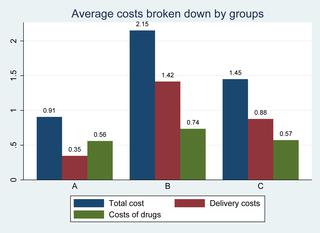当前位置:
X-MOL 学术
›
PLOS Negl. Trop. Dis.
›
论文详情
Our official English website, www.x-mol.net, welcomes your
feedback! (Note: you will need to create a separate account there.)
Cost of interventions to control schistosomiasis: A systematic review of the literature.
PLOS Neglected Tropical Diseases ( IF 3.4 ) Pub Date : 2020-03-30 , DOI: 10.1371/journal.pntd.0008098 Paola Salari 1, 2 , Thomas Fürst 1, 2 , Stefanie Knopp 1, 2 , Jürg Utzinger 1, 2 , Fabrizio Tediosi 1, 2
PLOS Neglected Tropical Diseases ( IF 3.4 ) Pub Date : 2020-03-30 , DOI: 10.1371/journal.pntd.0008098 Paola Salari 1, 2 , Thomas Fürst 1, 2 , Stefanie Knopp 1, 2 , Jürg Utzinger 1, 2 , Fabrizio Tediosi 1, 2
Affiliation

|
BACKGROUND
Schistosomiasis, a disease caused by blood flukes of the genus Schistosoma, belongs to the neglected tropical diseases. Left untreated, schistosomiasis can lead to severe health problems and even death. An estimated 800 million people are at risk of schistosomiasis and 250 million people are infected. The global strategy to control and eliminate schistosomiasis emphasizes large-scale preventive chemotherapy with praziquantel targeting school-age children. Other tools are available, such as information, education, and communication (IEC), improved access to water, sanitation, and hygiene (WASH), and snail control. Despite available evidence of the effectiveness of these control measures, analyses estimating the most cost-effective control or elimination strategies are scarce, inaccurate, and lack standardization. We systematically reviewed the literature on costs related to public health interventions against schistosomiasis to strengthen the current evidence-base.
METHODOLOGY
In adherence to the PRISMA guidelines, we systematically searched three readily available electronic databases (i.e., PubMed, WHOLIS, and ISI Web of Science) from inception to April 2019 with no language restrictions. Relevant documents were screened, duplicates eliminated, specific rules on studies to consider were defined, and the eligible studies fully reviewed. Costs of schistosomiasis interventions were classified in three groups: (i) preventive chemotherapy; (ii) preventive chemotherapy plus an individual diagnostic test to identify at-risk population; and (iii) test-and-treat interventions.
PRINCIPAL FINDINGS
Fifteen articles met our inclusion criteria. In general, it was hard to compare the reported costs from the different studies due to different approaches used to estimate and classify the costs of the intervention assessed. Costs varied considerably from one study to another, ranging from US$ 0.06 to US$ 4.46 per person treated. The difference between financial and opportunity costs only played a minimal role in the explanation of the costs' variation, even if delivery costs were two times higher in the analyses including economic costs. Most of the studies identified in our systematic review focused on sub-Saharan African countries.
CONCLUSIONS/SIGNIFICANCE
The degree of transparency of most of the costing studies of schistosomiasis interventions found in the current review was limited. Hence, there is a pressing need for strategies to improve the quality of cost analyses, and higher reporting standards and transparency that should be fostered by peer-review journal policies. Cost information on these interventions is crucial to inform resource allocation decisions and those regarding the affordability of scaling-up interventions.
中文翻译:

控制血吸虫病的干预措施成本:对文献的系统评价。
背景技术血吸虫病是由血吸虫属血吸虫引起的疾病,属于被忽视的热带病。如果不加以治疗,血吸虫病会导致严重的健康问题,甚至导致死亡。估计有8亿人面临血吸虫病的危险,2.5亿人受到感染。控制和消除血吸虫病的全球策略强调以吡喹酮为学龄儿童的大规模预防性化疗。还可以使用其他工具,例如信息,教育和通信(IEC),改善的用水,卫生和卫生(WASH)以及蜗牛控制。尽管有证据表明这些控制措施是有效的,但估计最具成本效益的控制或消除策略的分析却很少,不准确且缺乏标准化。我们系统地回顾了有关针对血吸虫病的公共卫生干预措施相关费用的文献,以加强当前的证据基础。方法论为了遵守PRISMA准则,从开始到2019年4月,我们系统地搜索了三个易于使用的电子数据库(即PubMed,WHOLIS和ISI Web of Science),没有语言限制。筛选相关文件,消除重复项,定义要考虑的研究具体规则,并对符合条件的研究进行全面审查。血吸虫病干预的费用分为三组:(i)预防性化疗;(ii)预防性化学疗法加上个人诊断测试,以识别高危人群;(iii)测试和治疗干预措施。主要发现15篇文章符合我们的纳入标准。一般来说,由于用于评估和评估干预措施成本的方法不同,因此很难比较不同研究报告的成本。从一项研究到另一项研究的费用差异很大,每位接受治疗的人的费用在0.06美元至4.46美元之间。财务成本和机会成本之间的差异在解释成本变化时仅发挥了最小的作用,即使在包括经济成本在内的分析中,交货成本高出两倍。我们的系统评价中确定的大多数研究都集中在撒哈拉以南非洲国家。结论/意义在本综述中发现的大多数血吸虫病干预措施成本研究的透明度有限。因此,迫切需要提高成本分析质量的策略,以及同行评审期刊政策应提高的报告标准和透明度。这些干预措施的成本信息对于决定资源分配决策以及扩大干预措施的承受能力至关重要。
更新日期:2020-03-30
中文翻译:

控制血吸虫病的干预措施成本:对文献的系统评价。
背景技术血吸虫病是由血吸虫属血吸虫引起的疾病,属于被忽视的热带病。如果不加以治疗,血吸虫病会导致严重的健康问题,甚至导致死亡。估计有8亿人面临血吸虫病的危险,2.5亿人受到感染。控制和消除血吸虫病的全球策略强调以吡喹酮为学龄儿童的大规模预防性化疗。还可以使用其他工具,例如信息,教育和通信(IEC),改善的用水,卫生和卫生(WASH)以及蜗牛控制。尽管有证据表明这些控制措施是有效的,但估计最具成本效益的控制或消除策略的分析却很少,不准确且缺乏标准化。我们系统地回顾了有关针对血吸虫病的公共卫生干预措施相关费用的文献,以加强当前的证据基础。方法论为了遵守PRISMA准则,从开始到2019年4月,我们系统地搜索了三个易于使用的电子数据库(即PubMed,WHOLIS和ISI Web of Science),没有语言限制。筛选相关文件,消除重复项,定义要考虑的研究具体规则,并对符合条件的研究进行全面审查。血吸虫病干预的费用分为三组:(i)预防性化疗;(ii)预防性化学疗法加上个人诊断测试,以识别高危人群;(iii)测试和治疗干预措施。主要发现15篇文章符合我们的纳入标准。一般来说,由于用于评估和评估干预措施成本的方法不同,因此很难比较不同研究报告的成本。从一项研究到另一项研究的费用差异很大,每位接受治疗的人的费用在0.06美元至4.46美元之间。财务成本和机会成本之间的差异在解释成本变化时仅发挥了最小的作用,即使在包括经济成本在内的分析中,交货成本高出两倍。我们的系统评价中确定的大多数研究都集中在撒哈拉以南非洲国家。结论/意义在本综述中发现的大多数血吸虫病干预措施成本研究的透明度有限。因此,迫切需要提高成本分析质量的策略,以及同行评审期刊政策应提高的报告标准和透明度。这些干预措施的成本信息对于决定资源分配决策以及扩大干预措施的承受能力至关重要。











































 京公网安备 11010802027423号
京公网安备 11010802027423号